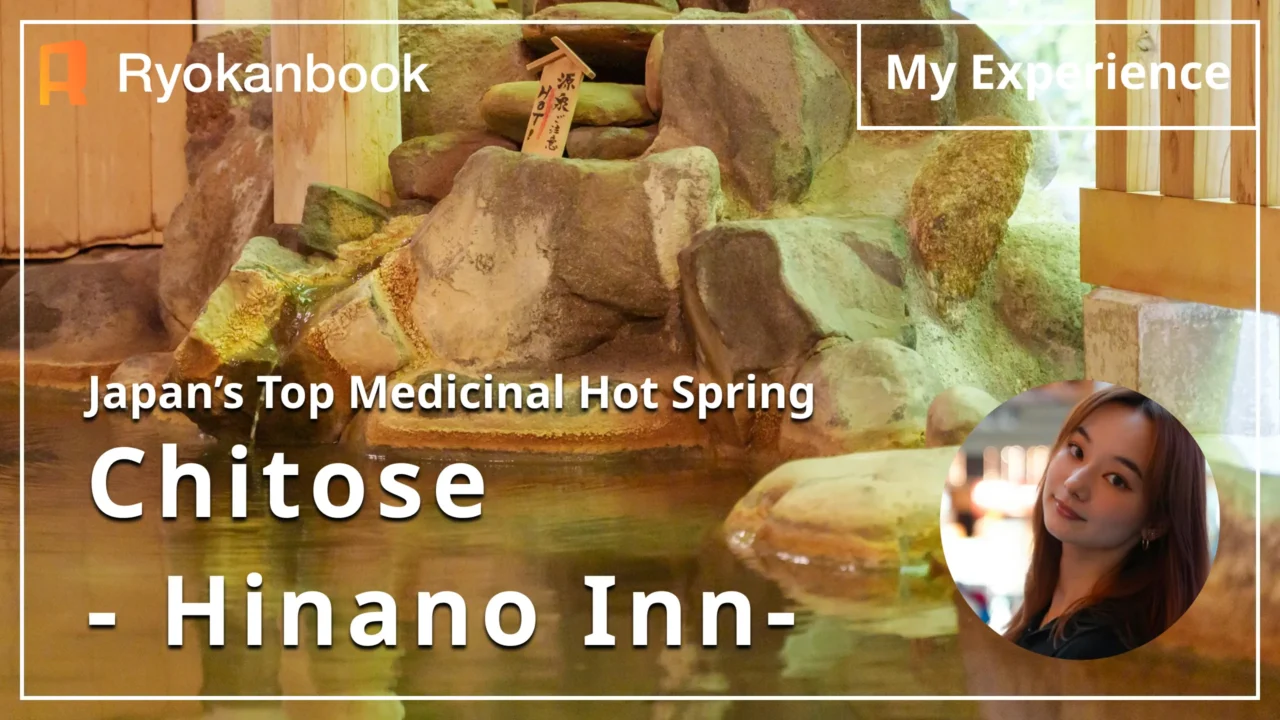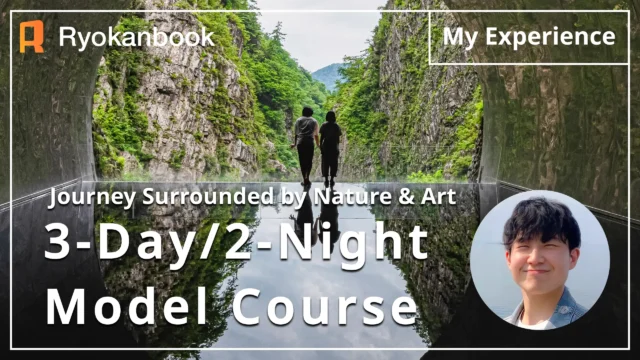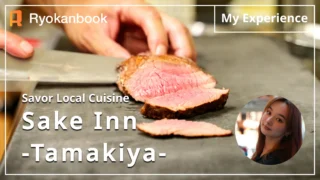Hello! I’m a university student living in Taiwan who loves traveling around Japan, exploring local lifestyles, culture, and the way people connect with their land.
This time, I’d like to share my stay at Hinano-yado Chitose, a traditional inn located in Matsunoyama Onsen (a hot spring village in Tōkamachi City, Niigata Prefecture).
It was a trip I took when I wanted to step away from my busy daily routine and simply breathe deeply.
Set in a small mountain hamlet, this inn is far more than just a place to sleep. Surrounded by the quiet beauty of Japan’s satoyama (the borderland where villages meet the mountains) and blessed with healing hot springs, I experienced a warm-hearted hospitality that allowed time to flow gently, making my stay deeply fulfilling.
▷View more details about Hinano-yado Chitose

Larisa Kawakami
Hello! I’m a university student currently living in Taiwan. As I travel around Japan, I look forward to encountering not only the people and the land, but also the everyday ways of life that have taken root in each place.
- Healing at Matsunoyama Onsen: Hinano-yado Chitose, One of Japan’s Top Three Medicinal Hot Springs
- The Moment You Truly Relax|Barefoot Comfort and Barrier-Free Design Throughout the Inn
- Relaxing Moments in the Semi-Suite Guest Room
- The Waters of Matsunoyama and the Energy of the Earth
- Flavors of Snow Country Memories and the Wisdom of Fermentation
- Terraced Rice, Nuka-gama Cooking, and the Signature “Rice-Centered” Tanada Hot Pot
- The Toji Bar: Continuing the Local Hot Spring Healing Tradition
- Solo Time in the Library
- A Morning Taste of Terraced Rice Fields Nurtured by Meltwater
- In Closing: A Stay at Hinanoyado Chitose, Matsunoyama Onsen
- 【Niigata – Tōkamachi】A One-Hour E-Bike Journey Through Satoyama Art and Nature
- Art Blending into the Rural Landscape
Healing at Matsunoyama Onsen: Hinano-yado Chitose, One of Japan’s Top Three Medicinal Hot Springs

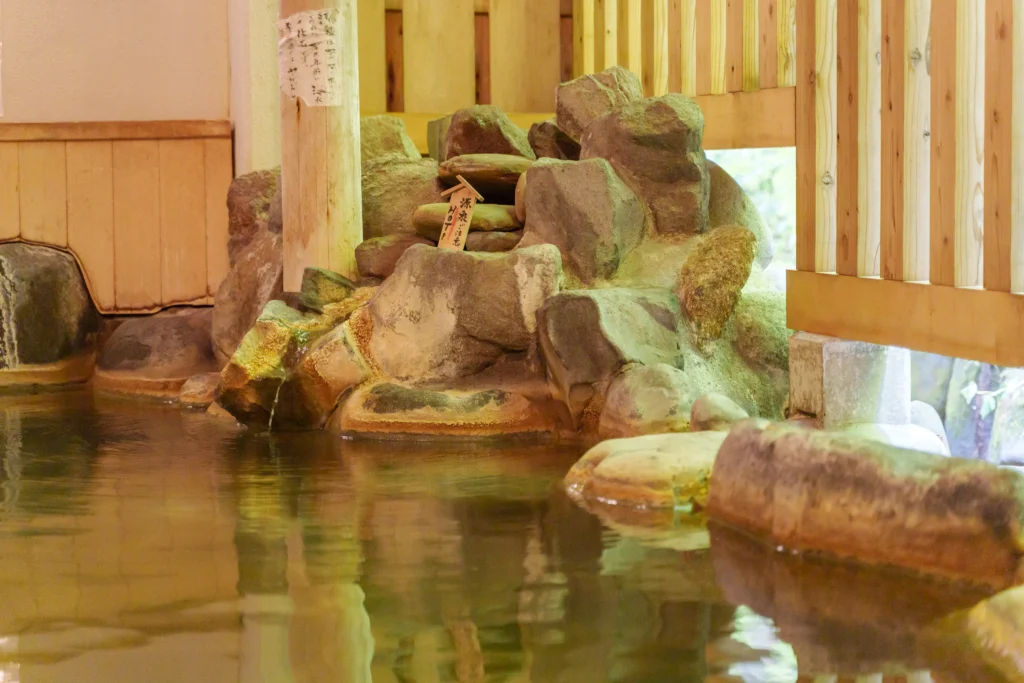
Matsunoyama Onsen is counted among Japan’s “Three Great Medicinal Hot Springs” (Nihon Sandai Yakutō), with a history of over 700 years as a healing retreat (tōji no sato).Unlike typical volcanic hot springs, it is a rare geopressure type onsen: ancient seawater, trapped deep underground, is heated by geothermal energy and gushes out at an astonishing 98°C (208°F).
Although it is classified as a chloride spring, the water feels surprisingly gentle on the skin. It retains heat well, keeping the body warm long after bathing, and its high salt content even creates a curious floating sensation in the bath.
The story of this land and its inn would not be complete without mentioning Mr. Kazunari Yanagi, the fourth-generation owner of Hinano-yado Chitose.
He recalls:
“This region is truly a land of heavy snow. In the past, people would mock us, saying, ‘Did you really come from such snowy mountains?’ That gave us a strong sense of inferiority. But in my father’s generation, he decided, ‘Let’s turn the snow into our strength.’ The snowmelt nurtures our rice and sake, so we want visitors from afar to taste what is truly unique to this land.”
As he spoke, his calm but confident gaze reflected a quiet pride in living in Japan’s snow country.
The Moment You Truly Relax|Barefoot Comfort and Barrier-Free Design Throughout the Inn
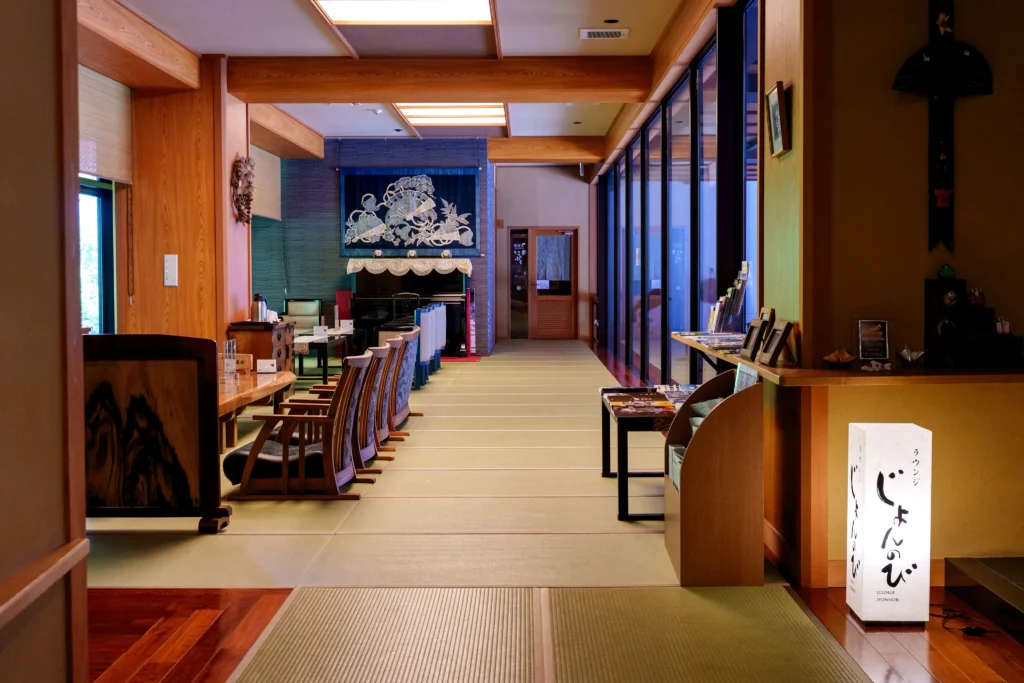
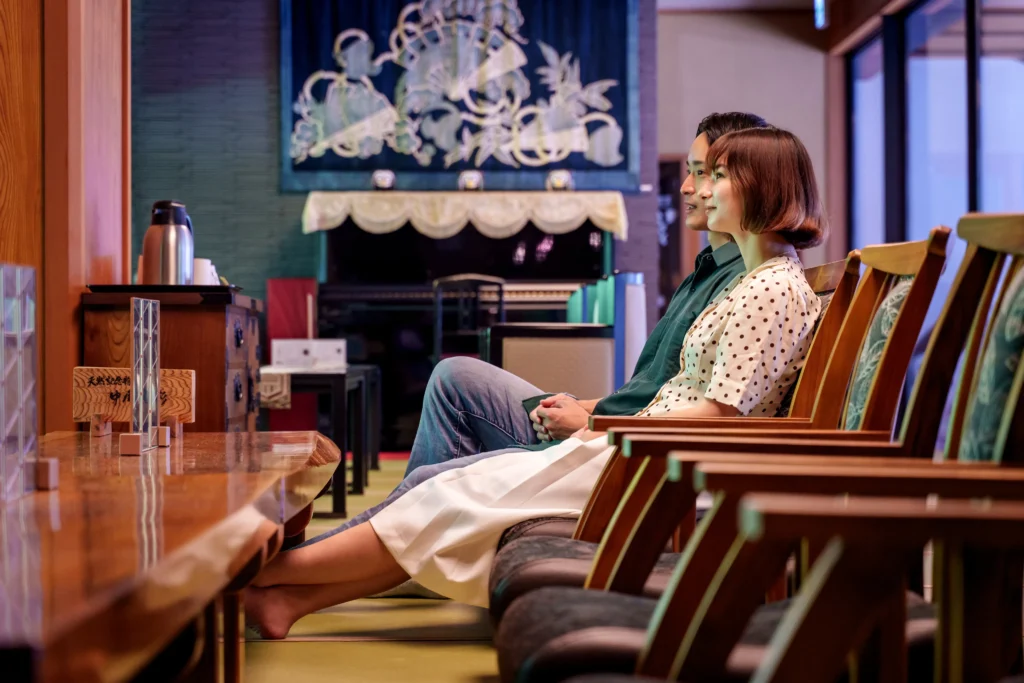
Inside the inn, the floors are entirely covered with tatami (traditional woven straw mats), so there’s no need for slippers. Walking barefoot across the soft tatami instantly brings a sense of nostalgia and comfort—almost like returning to a grandparent’s home.
The fourth-generation Yanagi family designed the inn with the idea that, just as travelers in the old days would remove their straw sandals (waraji) before entering, today’s guests should also have a moment to shed their tension upon arrival. To create this feeling, the building was designed with universal accessibility in mind: steps were eliminated, and handrails and slopes were seamlessly integrated into the architecture.
What impressed me most was that the inn doesn’t loudly advertise itself as “barrier-free.” Instead, the thoughtful design simply feels natural and comfortable for everyone.

Mr. Yanagi himself once suffered from back pain, and he told me, “I’m truly glad we made those changes back then.”
That spirit of kindness seems to permeate the very air of the inn. Even though I have no physical limitations, I still felt an extraordinary sense of being cared for and protected during my stay.
Relaxing Moments in the Semi-Suite Guest Room
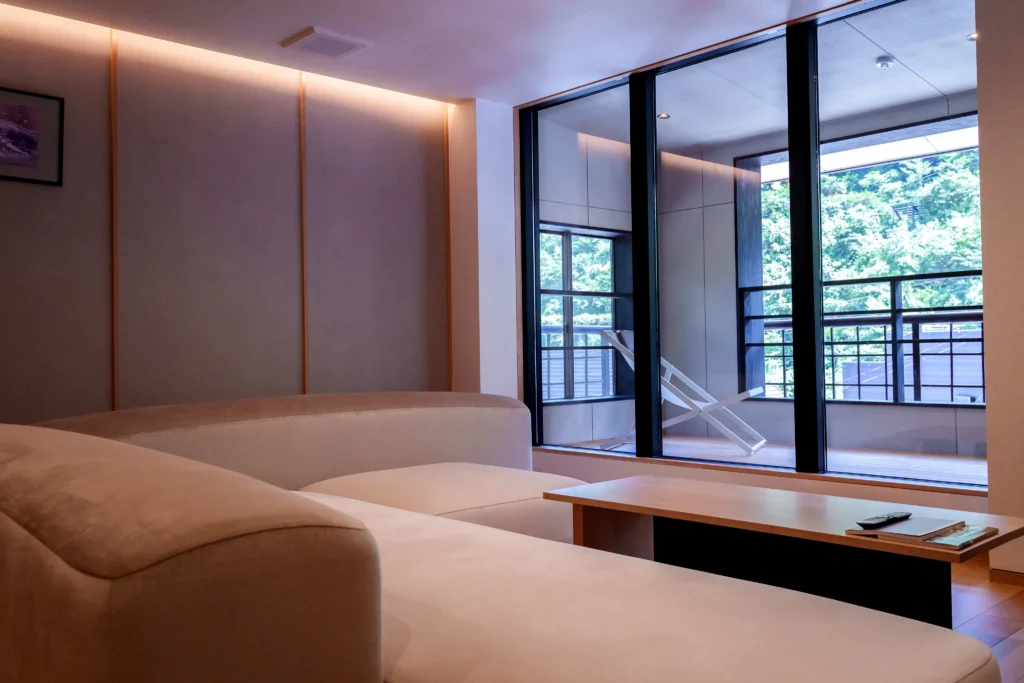

For this stay, I chose a semi-suite room—a touch of luxury compared to the standard guest rooms.
The space included a spacious living area, a fully equipped kitchen, a dining room, and even a private open-air hot spring bath attached to the room. Honestly, with all of these amenities, you could spend your entire trip without ever leaving the room.
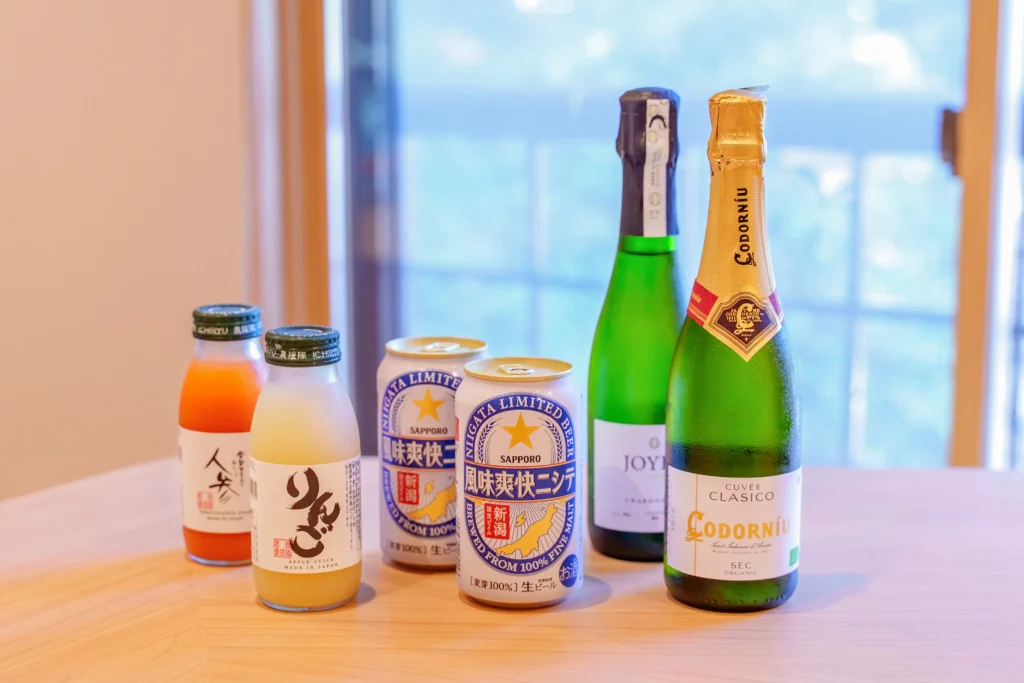

Looking out the window at the swaying greenery, I took a sip of locally produced apple juice. Its crisp tartness and clear sweetness were so refreshing that I finished the glass in one breath without realizing it.
The refrigerator was stocked with complimentary drinks, including sparkling water and a variety of juices. The apple and carrot juices, in particular, had a natural sweetness that tasted as if they came straight from the freshly harvested produce, gently revitalizing my body.
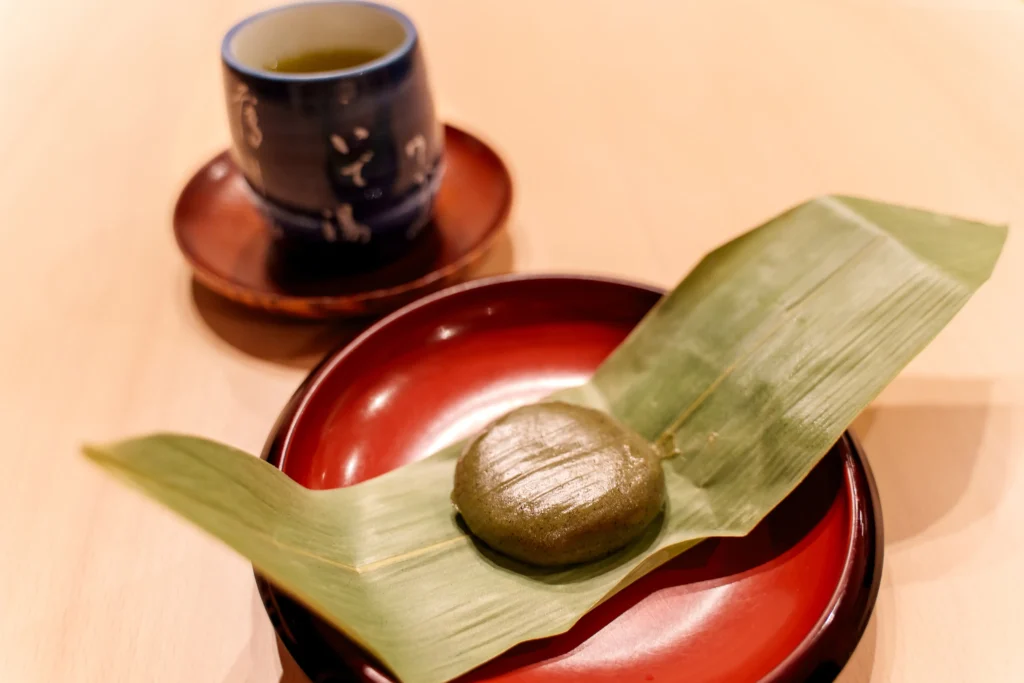
Next, I tried shinko mochi, a local rice cake delicacy. Wrapped in bamboo leaves, it carried a gentle fragrance of the leaves and a soft sweetness from the red bean filling that seemed to melt away stress from both body and mind.
The room itself was so comfortable that I felt I could easily settle in for several days. With a kitchen included, guests can even cook for themselves, making it an ideal choice for anyone who wants to enjoy a “live-in” style stay, as if truly living here.
The Waters of Matsunoyama and the Energy of the Earth
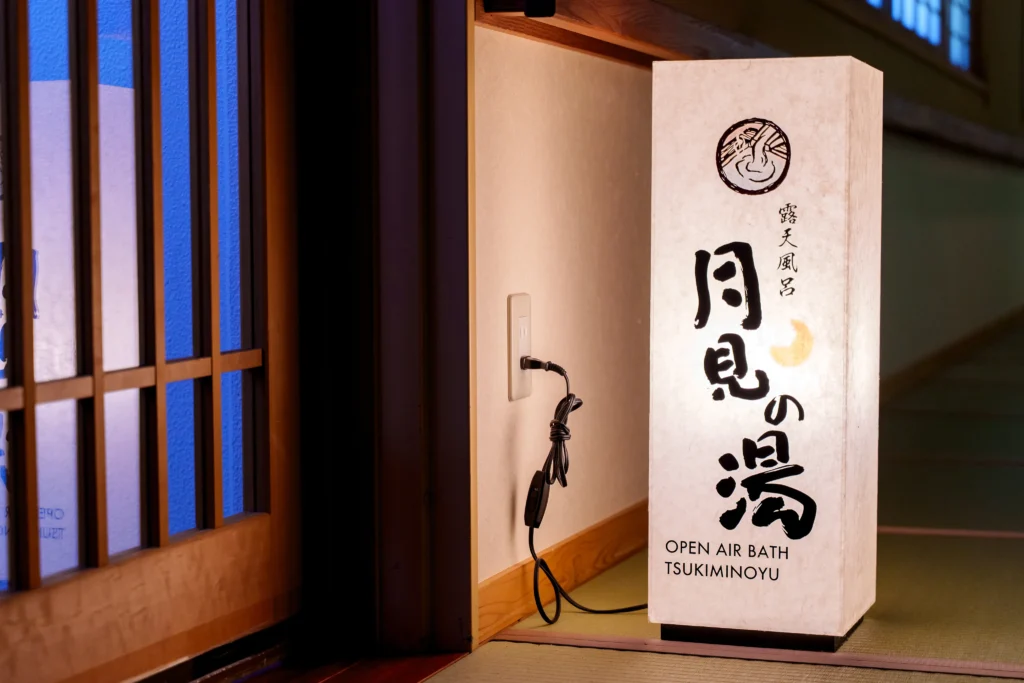

And then came the long-awaited hot spring bath. As I sank into the open-air rotenburo (outdoor hot spring bath), I felt the water’s relatively high temperature gently warming me from deep inside, wrapping me in a sensation as if my body and the hot spring were becoming one. More than simply warming the body, it gave me a profound sense of peace—almost like “returning to the land itself.”
In the large, traditional indoor bath, there was even a long wooden paddle used for stirring the hot water (yukaki-bō). Standing there, I couldn’t help but feel as though I had stepped into the fantastical world of Spirited Away, the famous Studio Ghibli film.


After my bath, I found a small rest area where complimentary onsen tamago (eggs slow-cooked in the hot spring water) and ice pops were laid out. Such thoughtful touches instantly brought a smile to my face.
It’s these quiet, understated gestures of hospitality that truly make you think, “I’d love to come back here again.
Flavors of Snow Country Memories and the Wisdom of Fermentation
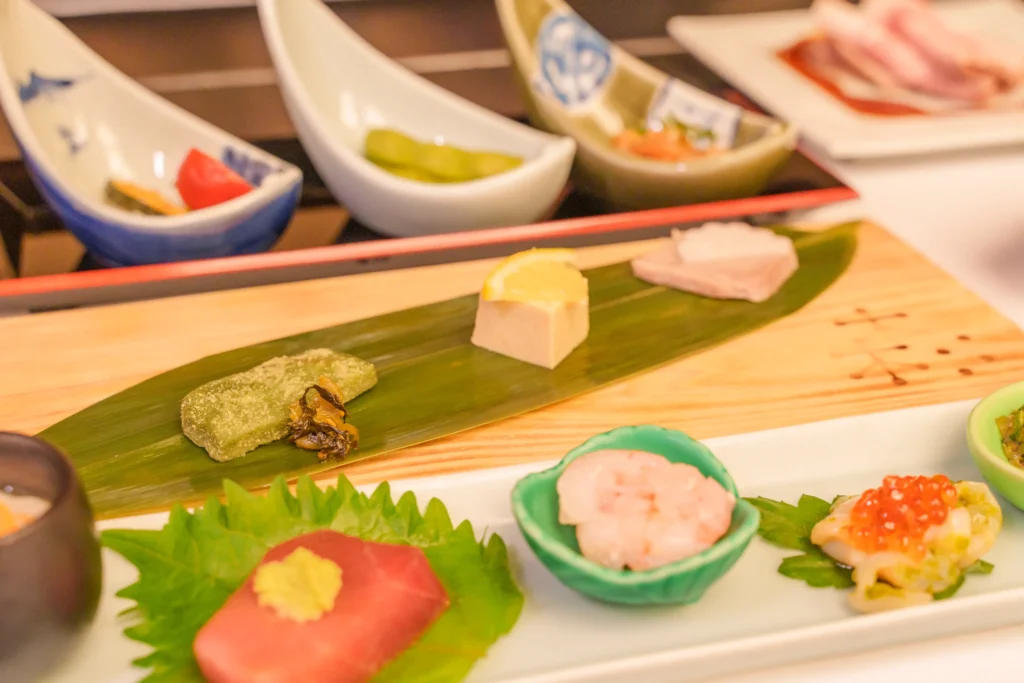
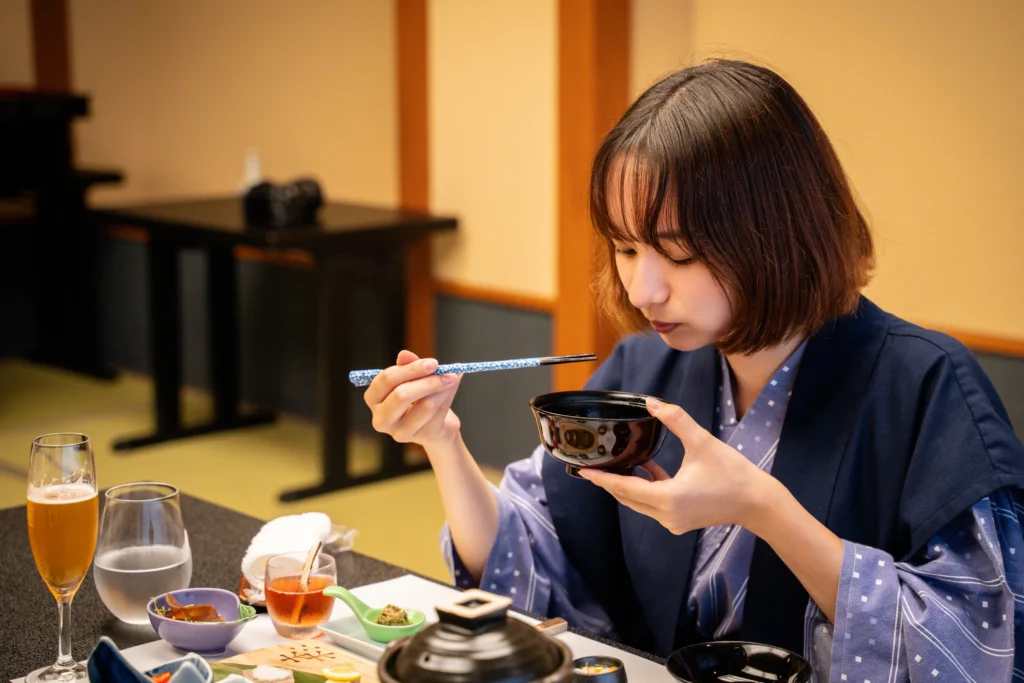
As evening fell and the inn was softly lit, it was time for dinner.
The first dish that caught my eye was a beautiful trio of appetizers arranged on a wooden plate, titled Onko Chishin—a Japanese phrase meaning “to learn new things by studying the past.” It felt like a single plate that encapsulated the “memories” of this land.
The first was yomogi-fu—fresh wheat gluten kneaded with Japanese mugwort (yomogi), lightly grilled and served with roasted soybean flour (kinako) and sautéed mustard greens. Its subtle fragrance and gentle flavor were deeply comforting.
Next was fermented tofu, made by aging local tofu in miso. Often called the “cheese of the snow country,” it paired perfectly with sake, offering both richness and umami.
Then came one of Chitose’s specialties: Tōji-buta, made with “Tsumaari Pork,” a premium local brand of pork from the Uonuma region. The meat was slowly cooked using the natural heat of the hot spring itself, resulting in a healthy yet deeply flavorful dish. Without relying on heavy seasoning, the natural taste of the ingredients shone through—reflecting the wisdom and sincerity of the satoyama (mountain village) lifestyle.
Another memorable dish was the pork shoulder loin, also from Tsumaari Pork, carefully prepared using low-temperature cooking techniques to bring out its tenderness and flavor.
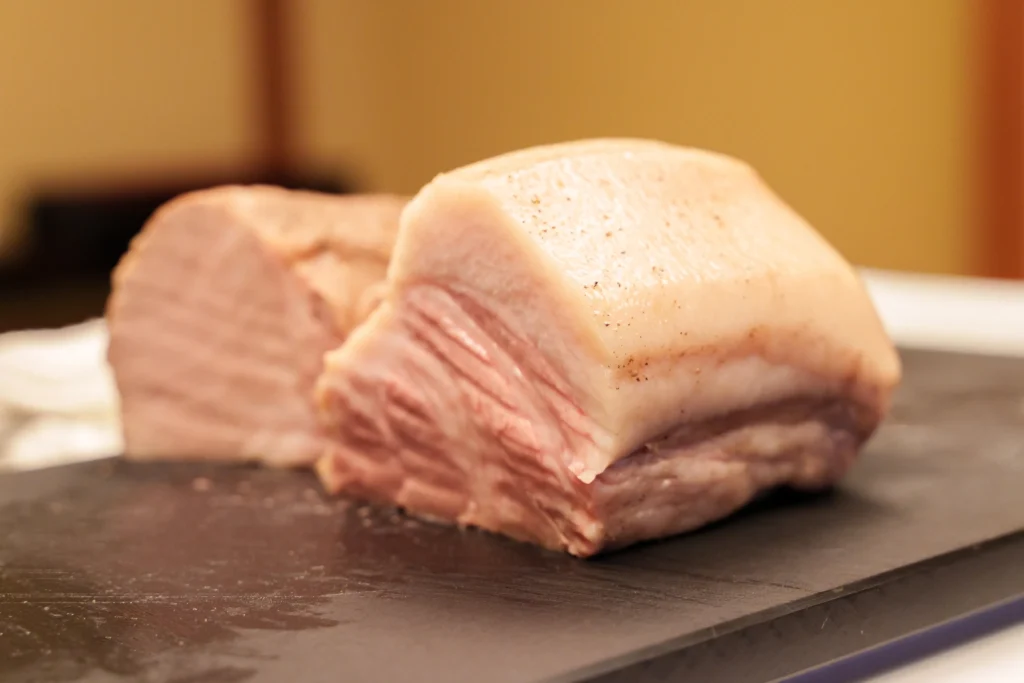
The fat was melt-in-your-mouth tender, carrying a faint sweetness thatperfectly complemented both rice and sake. In contrast, the lean meat offered a satisfying bite, releasing layers of umami that spread across the palate with every chew.
It was more than just “two flavors from one ingredient.” The contrast itself created a kind of ma—a Japanese concept of meaningful space or interval—that added remarkable depth to the overall taste.
Pork is also a familiar and beloved ingredient in Taiwan, yet I was deeply impressed by how much of the meat’s natural character could be revealed here through gentle cooking methods, such as harnessing the heat of the hot spring or using low-temperature techniques.
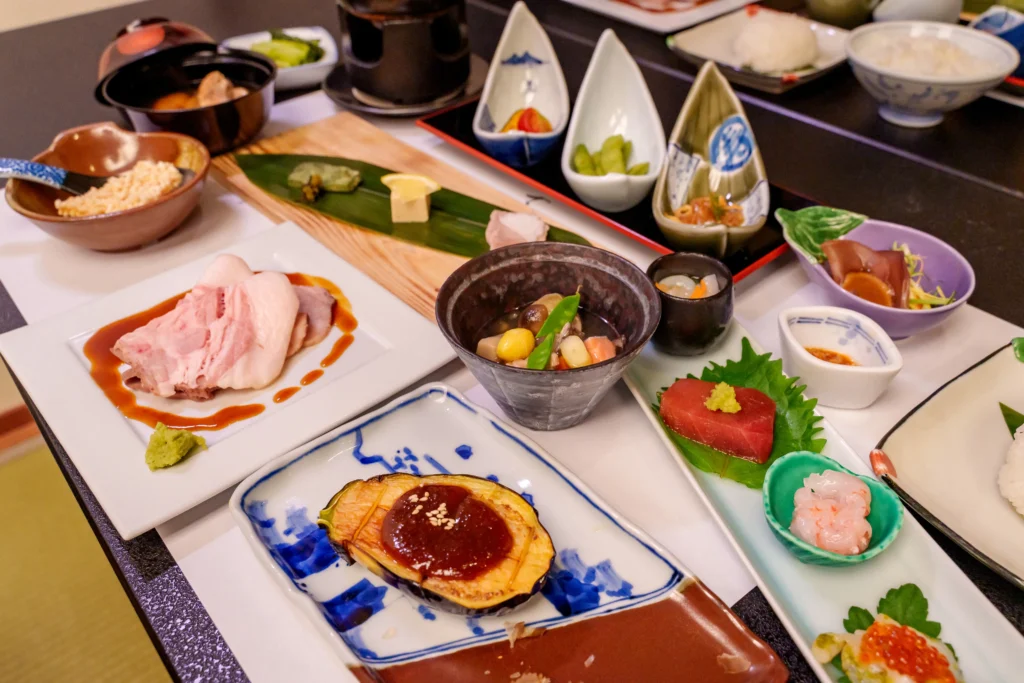
What makes the cuisine at Hinano-yado Chitose truly distinctive is that every dish is designed with one goal in mind: to enhance the enjoyment of rice and sake. According to the innkeeper, Mr. Yanagi, this philosophy stems from his desire to “serve food that we can be proud of—something unique to this place.”
Niigata is famous throughout Japan as both a rice-growing region and a sake-producing area. To highlight these blessings, Chitose takes an unusual approach: instead of treating rice as a side dish, they place it firmly in the spotlight. Rice is not only served at the end of the course, as is customary in Japanese dining, but appears several times throughout the meal—a rare and delightful experience.
The menu centers around locally sourced vegetables, mountain herbs, and fermented foods, each dish carrying a gentle flavor that feels as though you are tasting the land itself.
Terraced Rice, Nuka-gama Cooking, and the Signature “Rice-Centered” Tanada Hot Pot
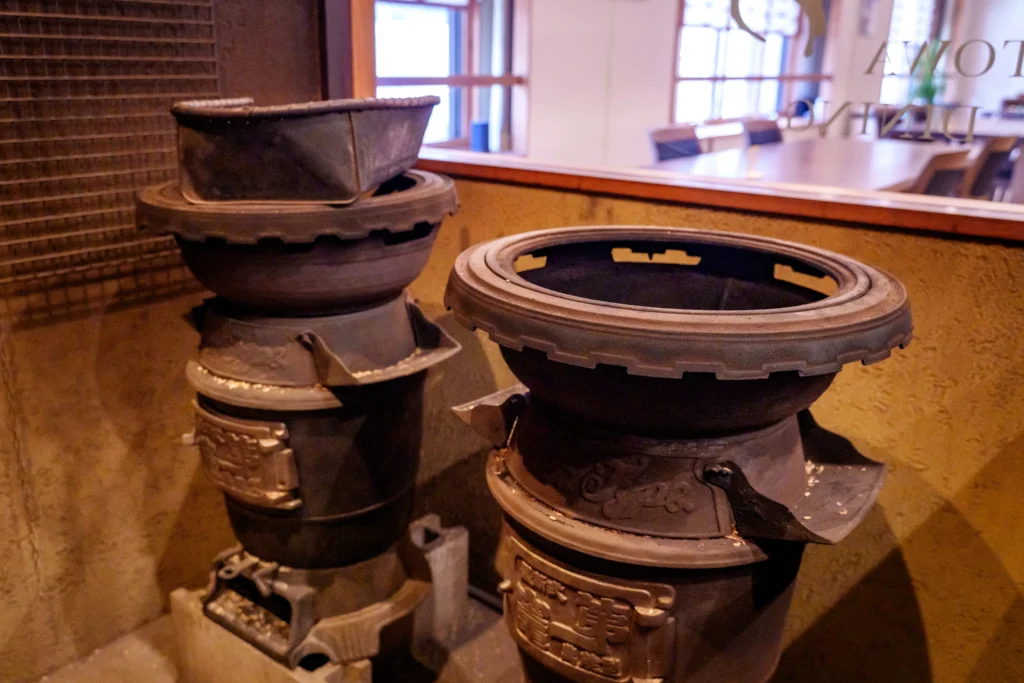
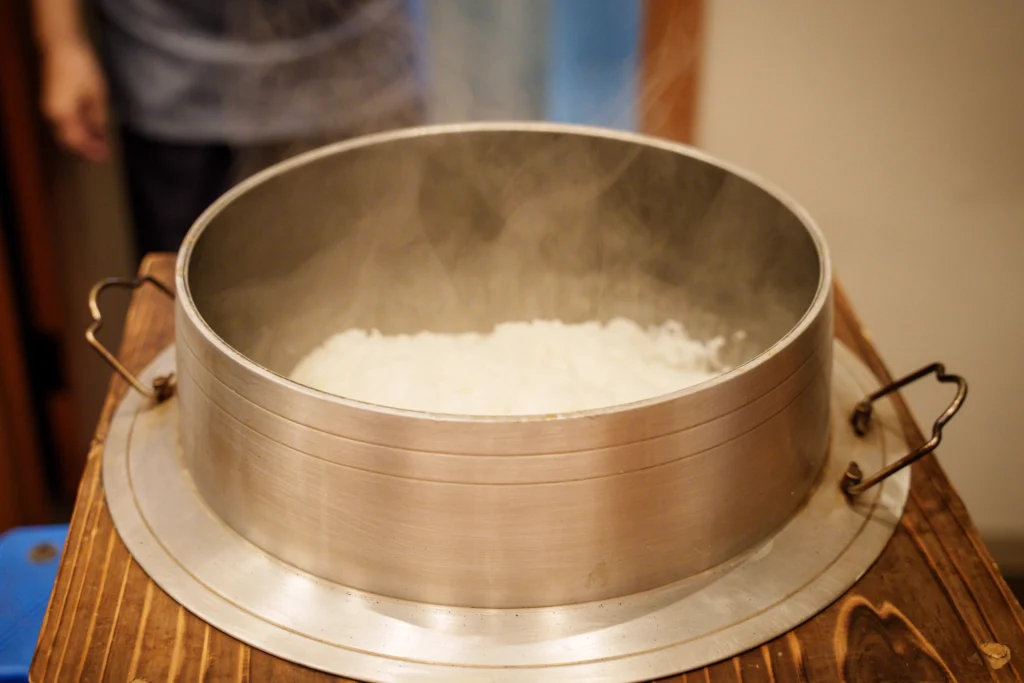
Let’s take a closer look at Chitose’s dedication to rice.
The rice served here is tanada-mai, grown in the terraced rice fields of Tōkamachi. These small fields in the Matsunoyama area are nourished by abundant snowmelt water, giving the rice a naturally rich flavor.
At Chitose, the rice is cooked in a traditional pot called a nuka-gama, which uses rice husks (momi) as fuel. This age-old method allows the rice to be served in its absolute best condition. After cooking, the ash produced is returned to the fields, helping to enrich the soil and maintain a healthy farming environment. It’s a perfect example of a “circular lifestyle,” one that reminded me of similar sustainable practices in rural Taiwan.

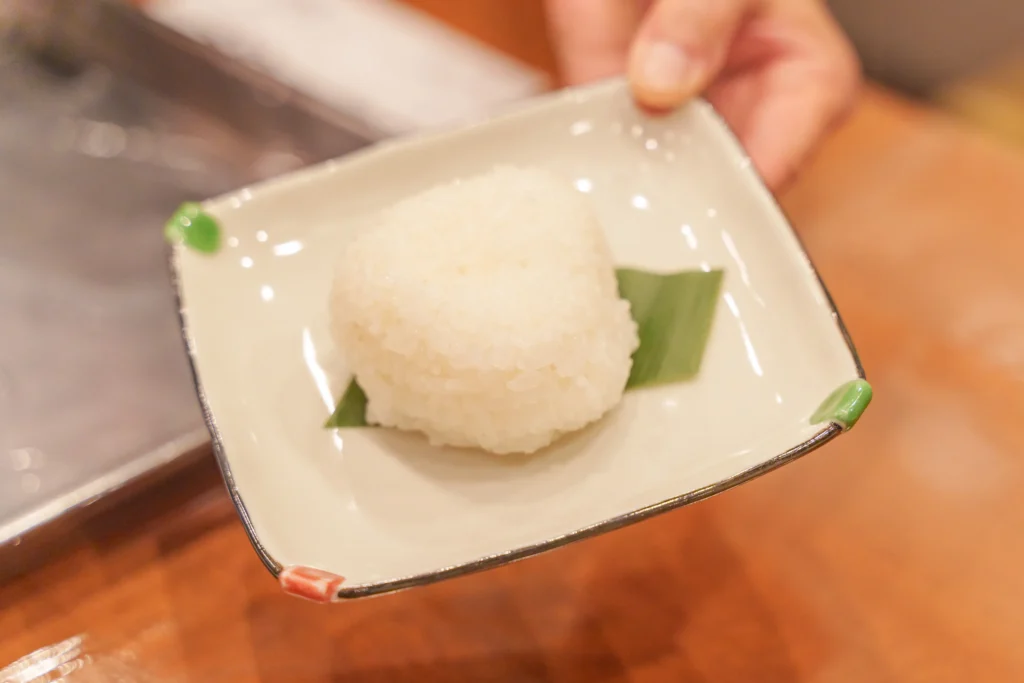
The freshly cooked tanada-mai rice from the nuka-gama was glossy, fragrant, and full of natural sweetness and stickiness that spread delightfully in my mouth with every bite. Among all the dishes, the one I won’t forget was the nuka-gama–cooked shio-musubi (salted rice ball).
Appearing midway through the dinner, almost like a sake appetizer, this simple yet elegant rice ball was lightly shaped by hand and sprinkled with just a touch of moshio—seaweed-infused salt.
This rice comes from terraced fields near the famous “Bijinbayashi” forest in Matsunoyama, which is blanketed with up to three meters of snow in winter. When spring arrives, the melting snow nourishes the paddies, producing rice with a rich sweetness and fragrant aroma.
As the saying goes, “just a salted rice ball, yet more than just a salted rice ball.” The combination of high-quality ingredients, careful preparation, and time itself created a quiet luxury that was truly unforgettable.
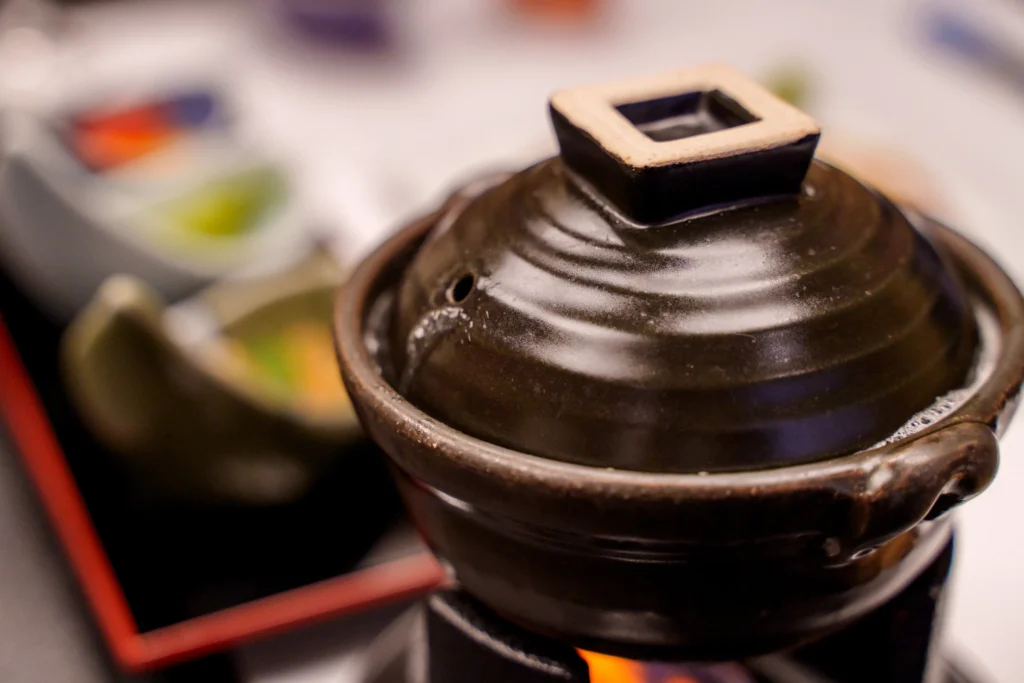

The full potential of this rice was revealed in a creative dish called the Tanada Nabe—a hot pot that could almost be described as “a pot for eating rice.” It was a rich, flavorful rice-based soup that showcased the natural sweetness and umami of the tanada-mai.
The rice was simmered slowly until it became creamy and tender, forming the heart of the dish. Seasonal local vegetables and a specialty aged meat called Koshino Kurenai were added, with grated daikon radish placed on top to resemble the gently falling snow of the region.
To finish, crispy rice crust (okoge) was added, lending a toasty aroma and a satisfying crunch. The underlying philosophy seemed clear: not a single grain of rice should go to waste. This was truly a bowl where rice was the undisputed star
The Toji Bar: Continuing the Local Hot Spring Healing Tradition


After dinner, I headed across the street from Chitose’s entrance to the Toji Bar for a light drink.
This unique space was created under the concept of “living in the hot spring town, not just staying in it.” The Toji Bar is more than just a bar—it combines a tourist information center, café & bar, co-working space, and even lodging facilities designed for long-term stays. It’s a place where the memory of Matsunoyama’s traditional tojiculture—extended stays at hot springs for healing—still lingers and continues to evolve.
In this region, it is said that during the agricultural off-season, local farmers would gather at the hot springs to heal their bodies, cook simple meals for themselves, and spend time in conversation.
The Toji Bar revives that scene in a modern way, offering a casual space where locals and guests can naturally connect. Since it is directly operated by Hinano-yado Chitose, you can even stop by after a bath in your yukata.
The bar serves not only drinks but also light meals, such as pizzas baked in a wood-fired oven that uses locally thinned beech and oak. You can enjoy a quiet drink alone, or strike up a natural conversation with people from the area. The atmosphere reminded me of Taiwan’s night market culture—a place of gentle, unforced encounters.
Before or after your dinner at the ryokan, I highly recommend visiting the Toji Bar for a taste of both relaxation and community.
Address: 9-4 Yumoto, Tokamachi City, Niigata 942-1432
https://maps.app.goo.gl/sfSBtEWeubUEBdXG6
Access: 1-minute walk from Hinano-yado Chitose / approx. 15 minutes by car from Hokuhoku Line Matsudai Station
Phone: 090-2386-1824
Hours: 4:00 PM – 11:00 PM (Last order 10:30 PM)
Closed: Mondays and Tuesdays
Solo Time in the Library
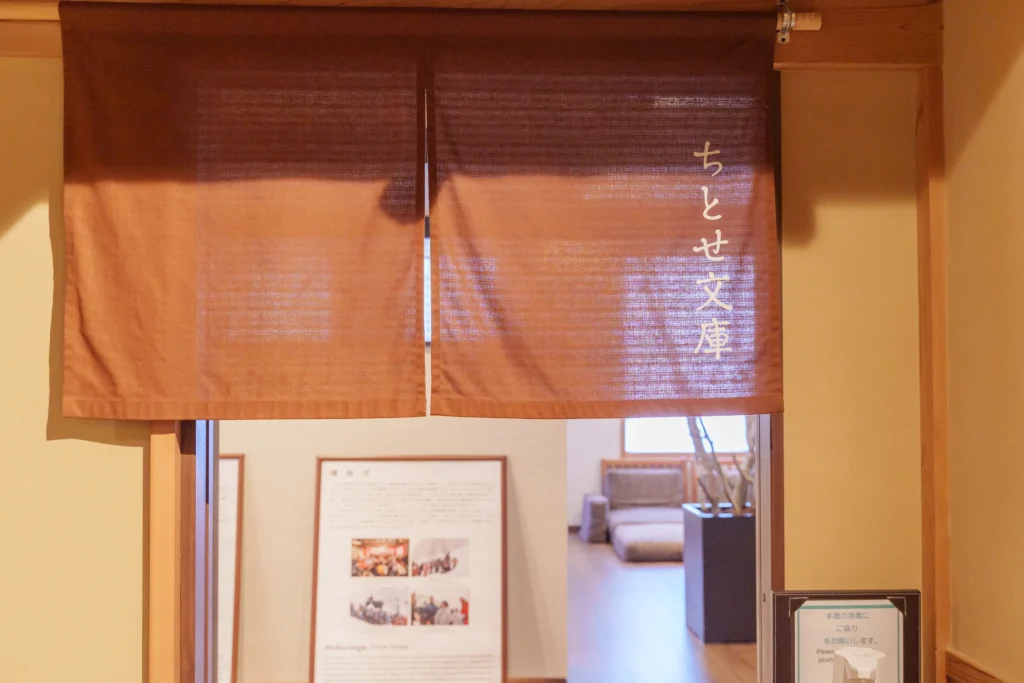
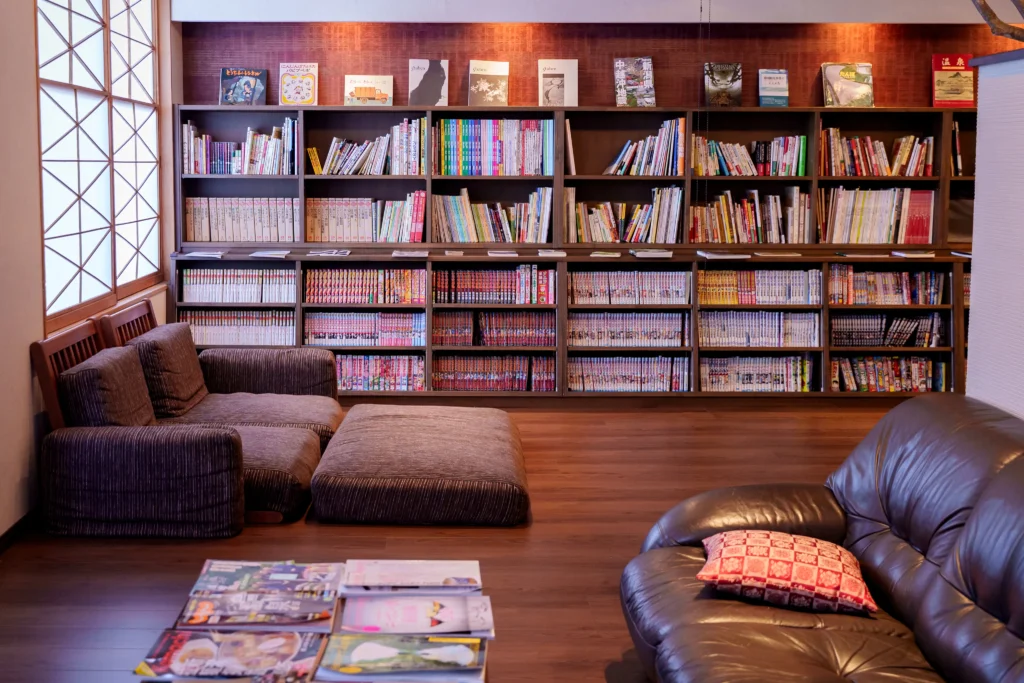
During my stay, I found myself drawn to the library “Chitose Bunko”—a peaceful retreat within the inn where you can let your mind settle into stillness.
Originally a dining hall, the space has been beautifully renovated into a cozy reading lounge. Shelves are lined with books on travel, nature, and culture, alongside handmade fabric crafts by the landlady and vintage objects that add warmth to the room.
What’s most touching is that about half of the collection was donated by an elderly woman who used to be a regular guest. Every year, she would arrive with two boxes of books and spend a week immersed in reading during her stay. Her presence seems to linger here, as if the books continue to connect people, places, and memories across time.

There’s something comforting about having a place where you can simply be alone in the middle of a journey. Thanks to this quiet space, my stay at Chitose felt even more relaxing and fulfilling.
A Morning Taste of Terraced Rice Fields Nurtured by Meltwater
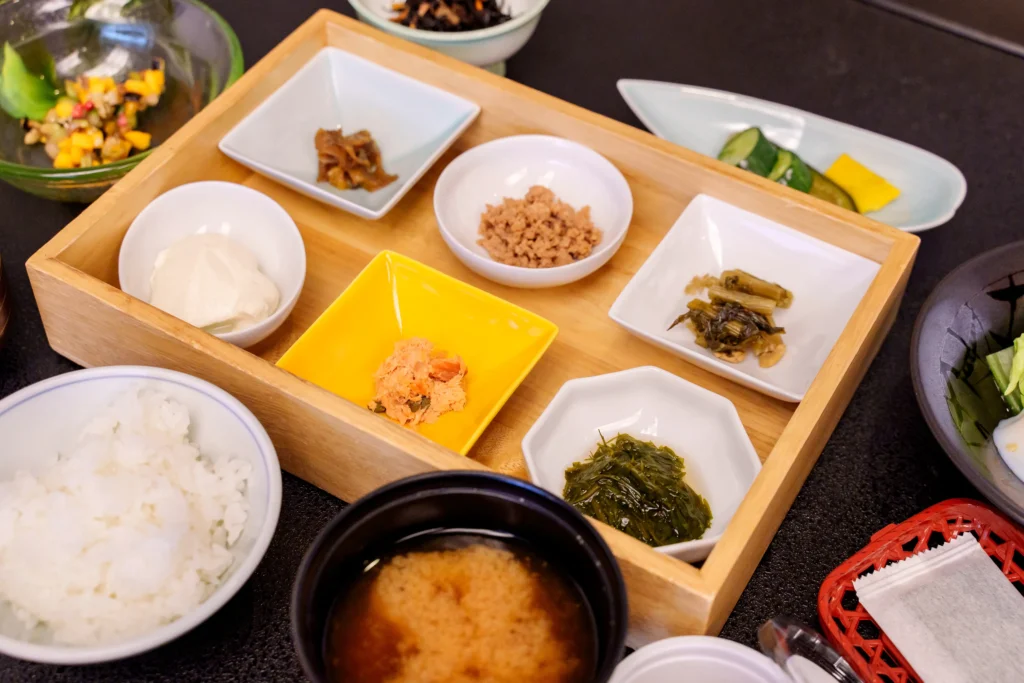
As morning comes, the gentle aroma of freshly cooked rice fills the air — a sign that the nukagama pot has finished its work.
In Matsunoyama, there is a long-held belief of shindo fuji — that eating the food grown in the land, in its proper season, brings balance to the body. This philosophy is reflected in the inn’s breakfast: freshly steamed terraced rice, miso soup, simmered vegetables, natto, and small dishes of mountain greens. The natto, unlike the kind sold in stores, had large, plump beans — a variety I had never tasted before — and paired perfectly with the warm, fragrant rice.
It was a simple yet heartfelt meal, one that let me taste the blessings of the land just as they are — gentle nourishment for a new morning.
I love the lively breakfasts in Taiwan — the sound of sizzling dan bing and the comforting aroma of warm soy milk. Yet, this quiet kind of luxury I found here felt like a different kind of richness — one that can only be experienced while traveling, when time slows and every breath feels deeper.
In Closing: A Stay at Hinanoyado Chitose, Matsunoyama Onsen
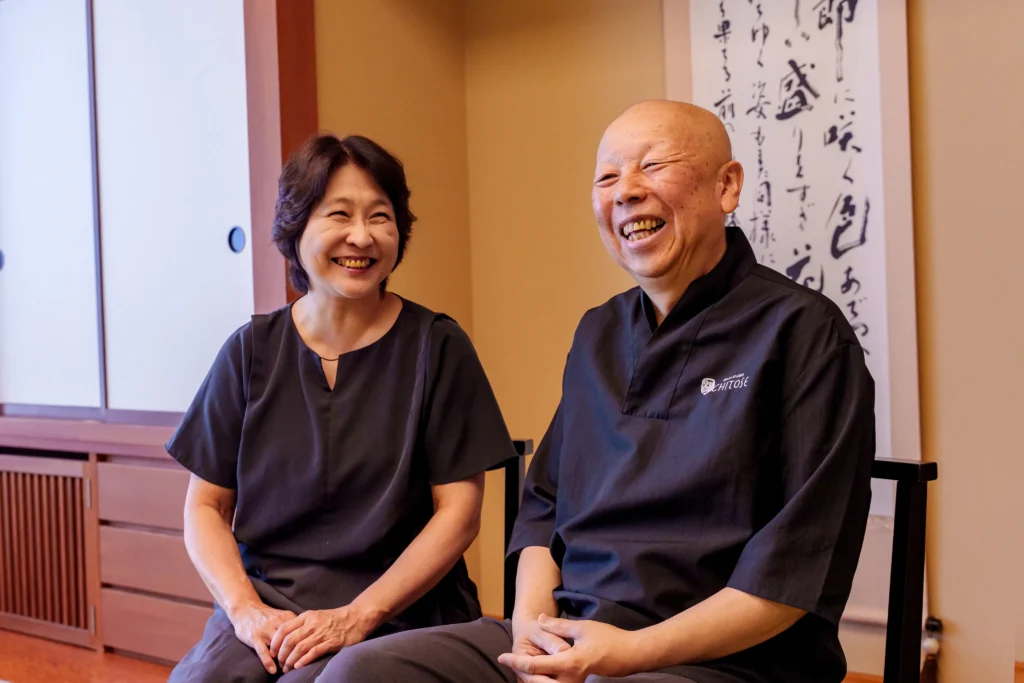
All in all, Hinanoyado Chitose truly embodies the words of its owner, Mr. Yanagi, who said he wishes the inn to be in a “mutual love” relationship with both the guests and the land itself.It is a place that gently reconnects people with the spirit of Matsunoyama.
The comfort of the semi-suite rooms that feel like a complete little world,
the liberating sensation of walking barefoot across tatami floors, the healing power of the hot spring, the quiet acts of hospitality that warm the heart, and the philosophy of meals that place rice—the essence of Japan—at the center. Each element reflects the unmistakable sense of place that can only be found here.
This inn, which lovingly carries on the satoyama culture—the traditional way of living in harmony with mountain villages and nature—is especially recommended for those who wish to learn from the wisdom and everyday life of the land itself.By the time you leave, you’ll likely find yourself saying softly, “I’ll be back again.”
Basic Information
Name: Matsunoyama Onsen – Hinanoyado Chitose
Address: 49-1 Matsunoyama Yumoto, Tōkamachi City, Niigata Prefecture, 942-1432, Japan
Access:
・By Train: About 15 minutes by car or shuttle from Matsudai Station (Hokuhoku Line). Advance reservation required for the shuttle service.
・By Car: Approximately 50 minutes from Shiozawa-Ishiuchi IC on the Kan-Etsu Expressway.
Parking: Available (25 spaces, free of charge)
▷View more details about Hinano-yado Chitose
After leaving the inn, I wanted to explore more of what Tōkamachi itself has to offer—so I set out on a journey to experience the Echigo-Tsumari Art Triennale, an art festival that celebrates the deep connection between people, land, and nature.
【Niigata – Tōkamachi】A One-Hour E-Bike Journey Through Satoyama Art and Nature
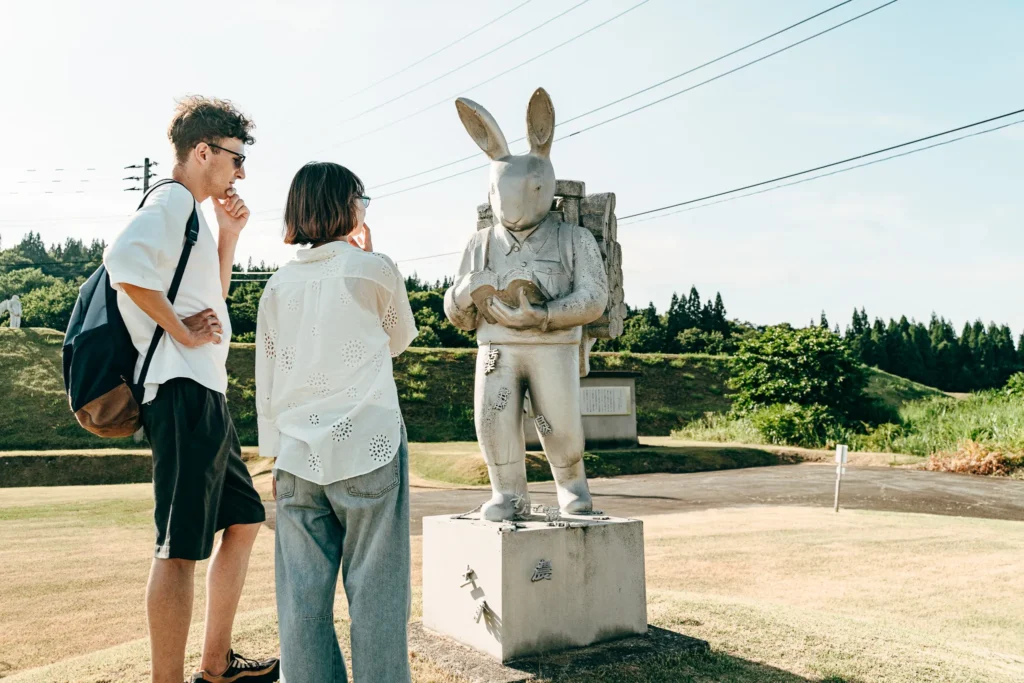
I’ve always loved visiting art museums and admiring buildings with beautiful design.
This time, I wanted to experience something a little different — the Echigo-Tsumari Art Triennale in Niigata’s Tōkamachi. As I walked through the city, I began to notice small yellow signs scattered around. These signs mark the locations of artworks that make up one of the world’s largest international art festivals. Blending nature, people, art, and everyday life, the festival has quietly taken root in the region since its first edition in 2000.
To explore its charm, I rented a sporty electric-assist bicycle called a Satoyama e-Bike and set out to visit some of the scattered artworks. My entire route, including stops for sightseeing, took about two hours — just enough to glimpse a fraction of what the Triennale has to offer. Yet even within that short time, I found myself wanting to return someday to see more. The art here isn’t something you can understand at first glance; it leaves space for imagination, inviting you to think, feel, and interpret in your own way.
▷Learn more about Echigo-Tsumari Art Triennale – Summary
25 Years Nurtured by the Echigo-Tsumari Art Triennale
Yayoi Kusama, Blooming Tsumari — Photo by Osamu Nakamura
Tracing back its history — the Echigo-Tsumari Art Triennale originated from the “New Niigata Satokoso (Village Creation) Plan” proposed by the governor of Niigata Prefecture in 1994.With the aim of breathing new life into rural areas struggling with depopulation and aging, the first edition was held in 2000.
At first, it took time for the local residents to fully understand and accept the idea. Yet through repeated dialogue, trust gradually began to grow. Then in 2004, when the Chuetsu Earthquake struck, artists and volunteers devoted themselves to helping clear the disaster-stricken areas.The relationships built through art deepened over time, transforming into genuine bonds within the community.
Art Blending into the Rural Landscape
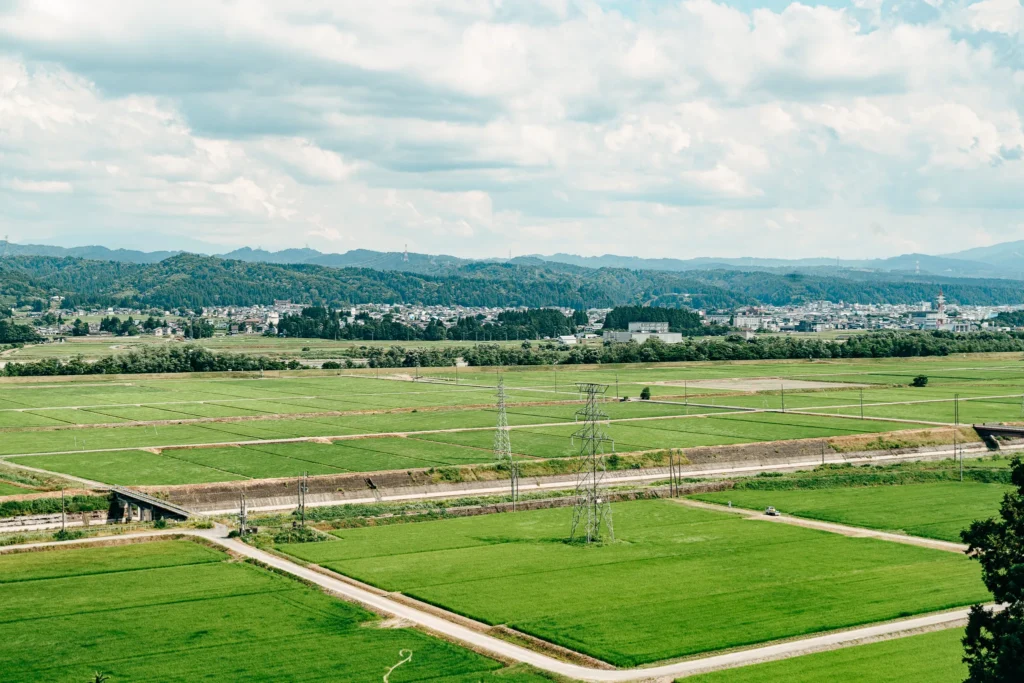
Across Tokamachi and Tsunan, artworks are scattered throughout the countryside — sculptures standing amid terraced rice fields, installations that transform abandoned houses, and creations that breathe new life into former school buildings. Each piece reflects the spirit of satoyama — the harmony between people and the land — capturing both the beauty of the natural landscape and the quiet rhythm of rural life.
The artworks are marked by small yellow signs, which are taken down during the region’s heavy winters and reinstalled each spring as the snow melts.
Art here doesn’t exist merely to be “seen”; it lives in harmony with the harshness of nature, seamlessly blending into the rhythms of local life.
Bringing Smiles to Grandparents” — The Heart Behind the Art Triennale

Ma Yanson / MAD Architects, Tunnel of Light — Photo by Osamu Nakamura
The overall director of the Echigo-Tsumari Art Triennale is art director Fram Kitagawa.The festival’s essence is perfectly captured in his simple phrase: “We want to make grandpas and grandmas smile.”
Why do artists from around the world gather in this remote satoyama, and why do new works continue to emerge year after year?
It’s because the festival has nurtured art not as a mere tool for regional revitalization, but as a medium to reconnect people.
Locals with artists, volunteers with residents, tourists with the rhythms of daily life — these diverse interactions blend together to form a living landscape. This is the everyday reality of the Echigo-Tsumari Art Triennale.
As a staff member from the local cultural tourism department explained,
“We weren’t trying to repeat the same things over and over. We just kept building on new experiments — and before we knew it, a quarter of a century had passed.”
Exploring the Satoyama by E-Bike
The journey began at the Tokamachi City Tourist Information Center, Tocco, located right next to Tokamachi Station. Here, you can rent a sports e-bike with electric assistance. Even if it’s your first time riding, the staff provide thorough instructions, making it easy and reassuring to get started.

We highly recommend using an electric-assist bicycle.
Tokamachi is full of hills, and pedaling for long periods can be more physically demanding than you might expect.
In the height of summer, the strong sun and humid heat can make cycling quite uncomfortable, so we generally don’t recommend summer rides. During the cooler seasons of spring and autumn, however, the breeze is pleasant, and cycling becomes a truly enjoyable experience.
Spot Name: Tokamachi City Tourist Information Center Tocco
Address: 251-17 Asahimachi, Tokamachi City, Niigata 948-0082, Japan (West Exit, Tokamachi Station)
https://maps.app.goo.gl/srJcPaBafixT87ke6
Access: West Exit, Hokuhoku Line Tokamachi Station
Phone: +81 25-757-3345
E-Bike Rental Period: Late April to November (closed during snowfall)
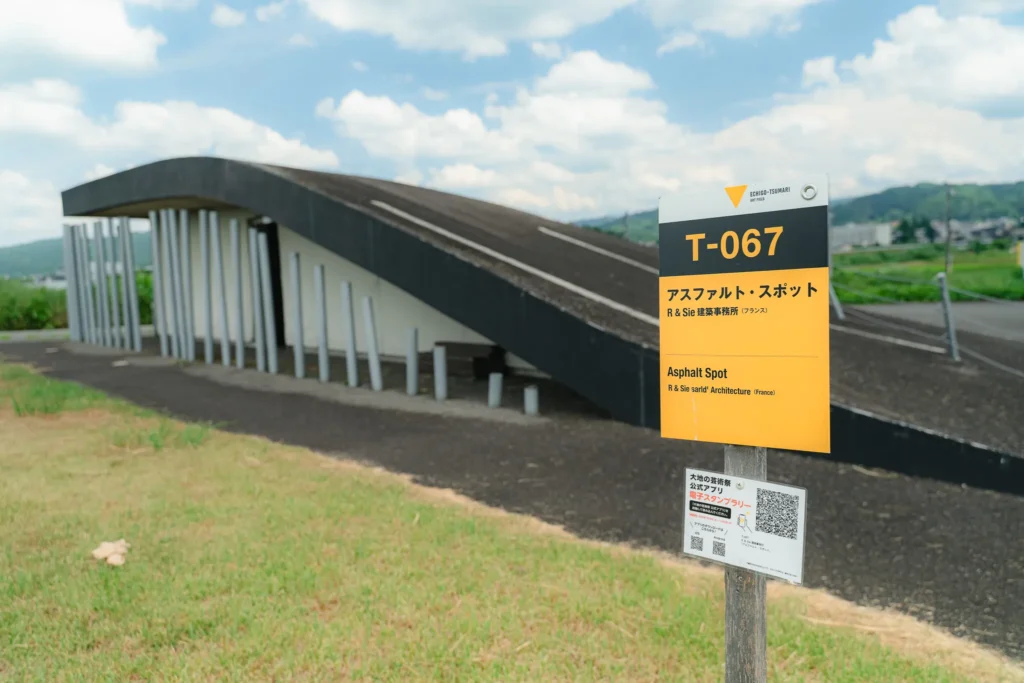
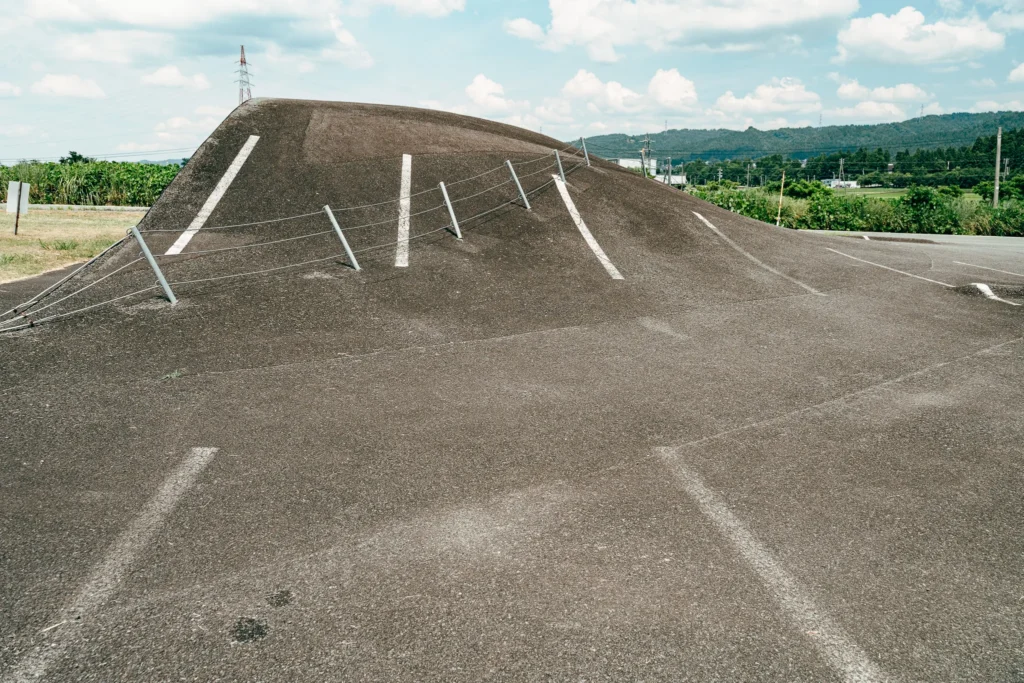
Our first destination was the Asphalt Spot, about a 15-minute ride from Tokamachi Station.
The abstract patterns painted on the ground change depending on the angle from which you view them, creating a fascinating optical illusion. From a distance, you might find yourself squinting and thinking, “Wait… is the ground bulging?”
It’s the kind of artwork that makes you pause and question reality: Is this a piece of art, or just part of the road? Experiencing the world from this unusual perspective was both intriguing and surprisingly stimulating.
Spot Name: Asphalt Spot
Address: 3-358 Tora, Tokamachi City, Niigata 948-0072,Japan
https://maps.app.goo.gl/nmyyR8QFnYms1fp88
Access: About 30 minutes on foot or 15 minutes by bicycle from Hokuhoku Line Tokamachi Station
Panoramic Views from the River Terrace
After about a 30-minute ride uphill from the Asphalt Spot, we emerged onto a road flanked by rice paddies, greeted by a view that instantly lifted our spirits.
In summer, the rice swayed gently in the breeze, producing a soothing rustling sound — the quiet rhythm of daily life in Tokamachi. For visitors like us, this “ordinary” scene feels like a moment plucked from a movie, a gentle taste of the extraordinary.
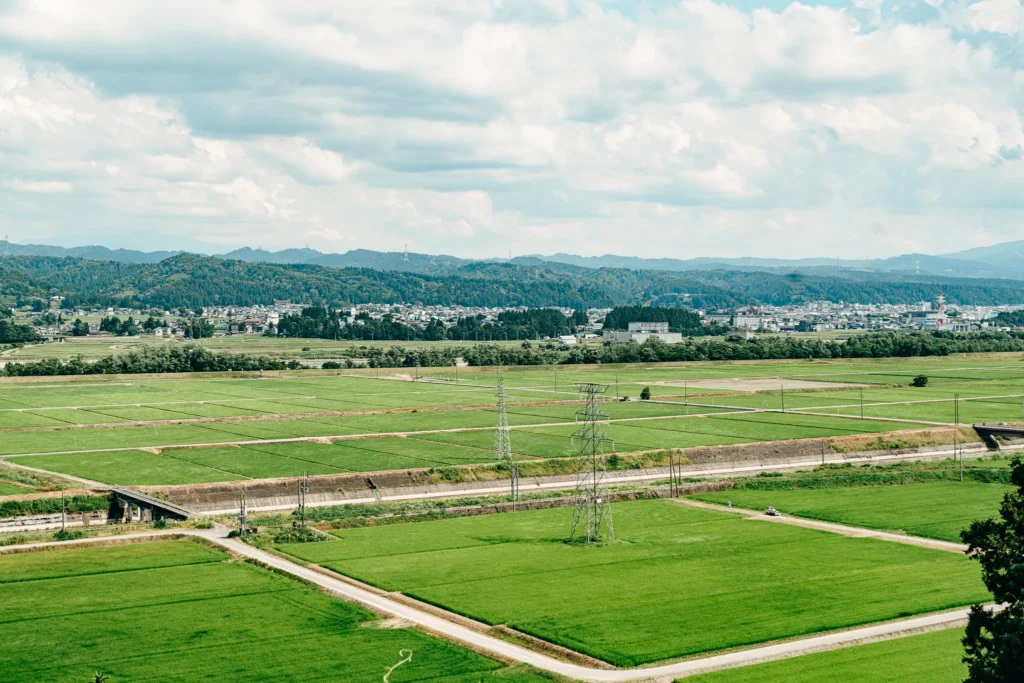
After riding straight for about five minutes, we spotted a sign on the right. Parking our bicycles nearby, we followed a small path — and suddenly, the view opened up, revealing a three-dimensional panorama of the satoyama landscape.

In spring, fresh greenery carpets the hills; in summer, deep green fields stretch under brilliant blue skies. Autumn brings crimson leaves and golden rice paddies, and winter wraps everything in pure white snow. It’s as if the four seasons take turns performing on the same stage.
But the charm lies in more than just the vastness of the view. From here, you can see clusters of villages scattered across the terraces, shimmering rivers, and the rhythm of everyday life woven into the landscape. A quiet story unique to this place begins to unfold before your eyes.
The feeling of openness makes you want to take a deep breath—and the lingering sense that you’ll want to return someday stays with you. Far from the noise of the city, this is a place where you can truly become one with nature.
Spot Name: River Terrace Viewpoint
Address: 948 Isehiraiji, Tokamachi City, Niigata 948-0131, Japan
https://maps.app.goo.gl/3GcD44QC4VQEaQqs8
Access: About 15 minutes by car or 30 minutes by bicycle from Hokuhoku Line Tokamachi Station
Awakening the Senses at the House of Light

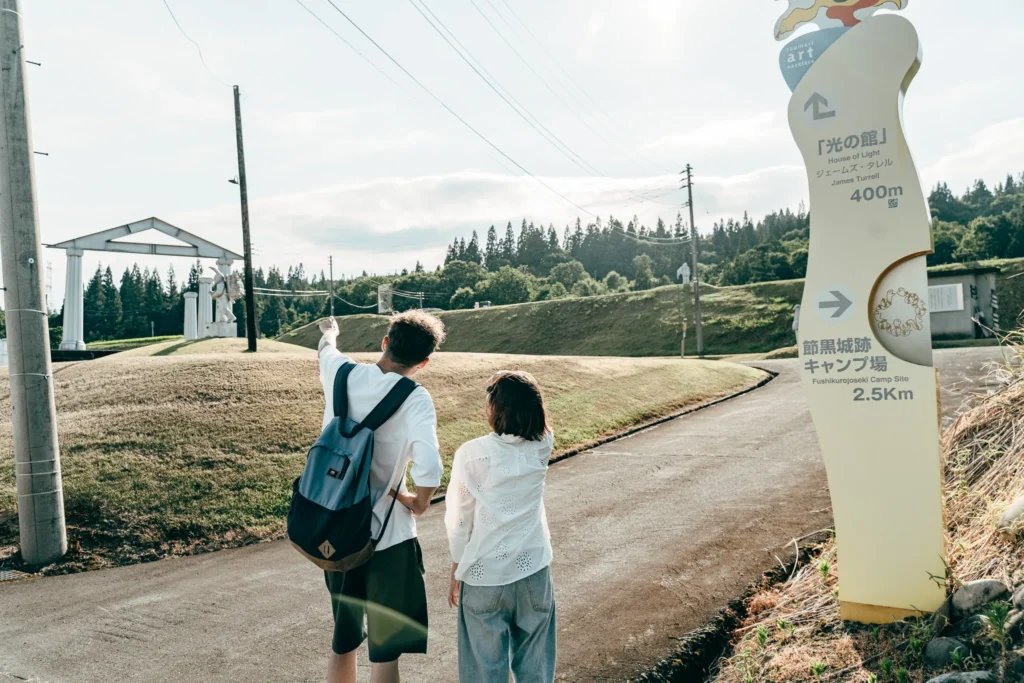
For the final stop of our journey, we visited James Turrell’s House of Light.
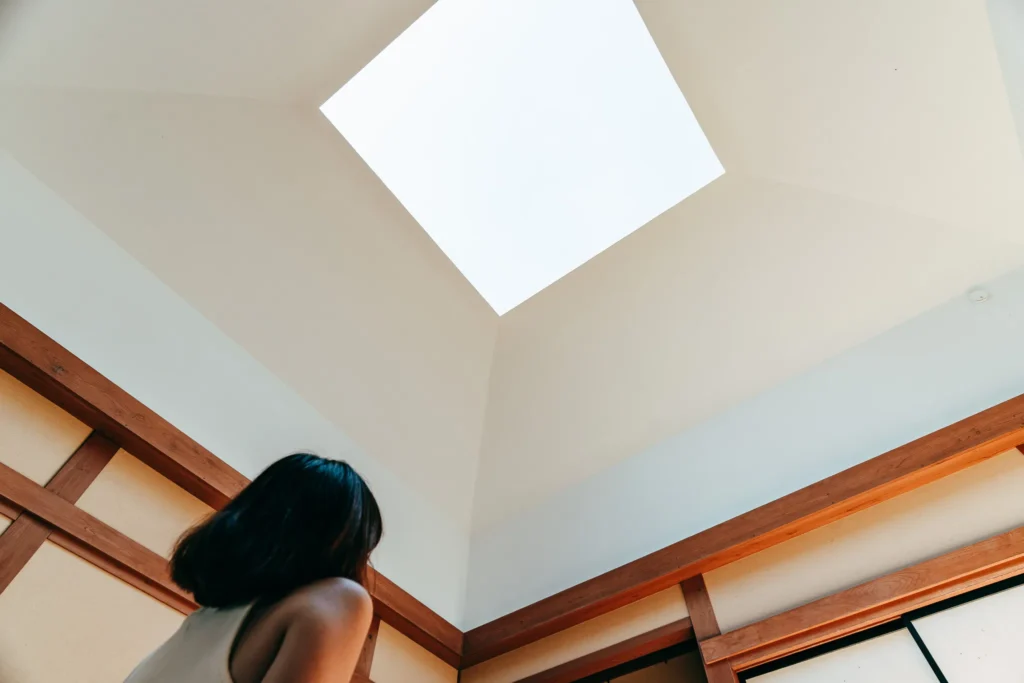
When the central part of the ceiling slowly opens, the sky itself becomes a “framed piece of art.” Watching the colors and light gradually shift makes even the passage of time feel slower. You become aware of the gentle breeze, the temperature of the air, the movement of the clouds — and before you know it, you naturally take a deep, calming breath.

The House of Light is also available for overnight stays, and guests can experience special programs called “Dawn Light” and “Evening Light.” The atmosphere changes completely between night and morning, so if you have the time, it’s highly recommended to experience both. Turrell drew inspiration from Jun’ichirō Tanizaki’s In Praise of Shadows, creating, simply put, a house where you can quietly savor light and shadow.
We only visited for the day, but on our way out, we looked up at the retractable roof from outside and thought, “Ah, so that’s how it moves!” — a satisfying glimpse of the structure in action. The view must change with the seasons and the weather, so next time we hope to stay overnight and watch the light shift slowly. Combined with the gentle fatigue from our cycling, the stillness of the space seeped pleasantly into our bodies.
Spot Name: House of Light
Artist: James Turrell (USA)
Address: 2891 Kamino-Ko, Tokamachi City, Niigata 948-0122, Japan
Phone: +81 25-761-1090
Access:
・By Train: About 20 minutes by car or 60 minutes by bicycle from Tokamachi Station
・By Car: About 35 minutes from Kan-Etsu Expressway Muikamachi IC, or about 1 hour from Kashiwazaki IC
Summary | Exploring the Echigo-Tsumari Art Triennale by Satoyama E-Bike

The e-bike tour through the Satoyama to explore art wasn’t just a way to get from one place to another—it was a full sensory immersion into Tokamachi. The artworks that appeared along the roads, the rustling of rice swaying in the wind, the expansive views of terraced fields in the distance, and the quiet stillness inside the House of Light—each moment left a lasting impression.
Even now, I find myself recalling these experiences in fleeting moments, as if the memories themselves have become part of the landscape.
Tips for Your Satoyama E-Bike Art Tour:
- Best seasons: Spring and autumn are ideal; summer can be very hot and sunny, making cycling challenging.
- E-bike recommended: The area has many hills, so an electric-assist bicycle is essential for an enjoyable ride.
- The House of Light offers exclusive programs only for overnight guests. If this interests you, it’s worth staying at the facility to experience them.
For those who want to enjoy nature and art at their own pace, this is a place best visited slowly, with careful attention to the season.
Spot Name: Satoyama E-Bike | Art Tour (House of Light Edition)
Organizer: Tokamachi City Tourism Association
Starting Point: Tokamachi City Tourist Information Center “Tocco”
Address: 251-17 Asahimachi, Tokamachi City, Niigata 948-0082, Japan (West Exit, Tokamachi Station)
https://maps.app.goo.gl/srJcPaBafixT87ke
Access to the Starting Point:
・By train: Take the Shinkansen from Tokyo to Echigo-Yuzawa Station (approx. 70 minutes), then transfer to the Hokuhoku Line to Tokamachi Station (approx. 35 minutes).
・By car: Driving times vary depending on your starting area; see below for reference to Tokamachi City.
①From Tokyo【via Kan-Etsu Expressway】
Approx. driving time: 3 hours 40 minutes
Nearest IC: Kan-Etsu Expressway, Muikamachi IC or Shiozawa-Ishiuchi IC
From Muikamachi IC: Route 253, approx. 30 minutes
From Shiozawa-Ishiuchi IC: Route 17 → Ōsawayama Tunnel
→ Prefectural Route 76, approx. 40 minutes
First-time visitors are recommended to use Muikamachi IC.
②From Nagoya (via Chuo Expressway → Nagano Expressway → Joshin-Etsu Expressway)
Approx. driving time: 5 hours 30 minutes – 7 hours
Nearest IC: Joshin-Etsu Expressway, Toyoda-Iiyama IC
From Toyoda-Iiyama IC: Route 117, approx. 1.5–2 hours
③From Osaka (via Meishin Expressway → Hokuriku Expressway)
Approx. driving time: 7–8 hours
Nearest IC: Hokuriku Expressway, Joetsu IC
From Joetsu IC: Route 253, approx. 1.5 hours
Hours: 9:00 – 17:00
Satoyama E-Bike Rental Info:
Rental period: Late April – November (closed during snowfall)
Rental fees: 2,000 JPY for 4 hours / 3,000 JPY for 1 day (tax included)
Parking: Free parking available at Tokamachi Station
Written by Larisa Kawakami
Translation: Ryokanbook Editorial Team

